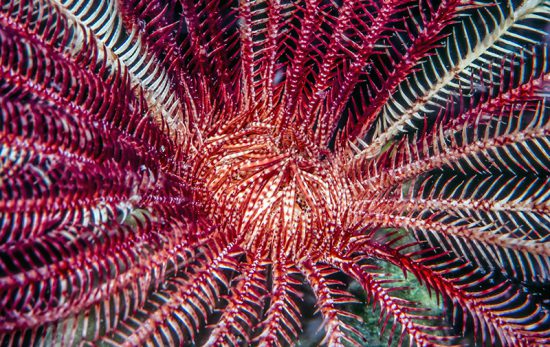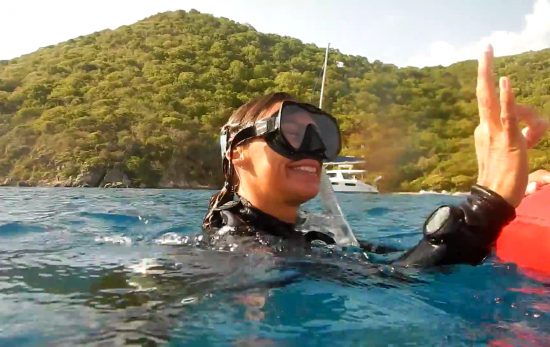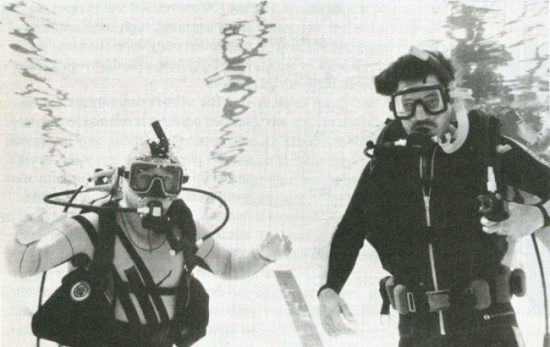Assembling a list of the most important women in scuba diving history is no easy task. We began with dozens of women but ultimately narrowed it down to the seven amazing divers below.
We hope this list is merely a starting place that inspires you to learn more about female contributions to scuba diving.
Dottie Frazier
Our list begins with Dottie Frazier. One of scuba’s living legends, she’s a woman who can claim many “firsts” in scuba. Her diving career began teaching freediving in the 1940s. She is widely recognized as one of the first female scuba instructors, female dive shop owners, and female hard-hat divers. Dottie also produced wetsuits and drysuits for the US Navy, as well as recreational divers, under her brand, Penguin Suits. You can read more about her life in her autobiography, Trailblazer: The Extraordinary Life of Diving Pioneer Dottie Frazier.
Listen to a 2016 interview with Dottie Frazier from the Scuba Guru podcast, or see historical news clippings of this amazing woman.
Dr. Sylvia Earle
Dr. Sylvia Earle is a diving icon, period. As one of the most famous oceanographers in the world and best-known women in diving, to many, her renown is second only to Cousteau’s. A trailblazer in marine research and exploration, her achievements are include a lot of firsts.
TIME magazine named her the first Hero of the Planet in 1998 for her groundbreaking research on marine ecosystems. Between 1990 and 1992, she was the first female chief scientist at the United States National Oceanic and Atmospheric Administration (NOAA). And in 1970, she led the first all-female team of aquanauts as part of the NASA-sponsored Tektite II mission. They spent 14 days in a submerged laboratory, living and carrying out research on the seabed. A pioneer in the development of deep-sea submersibles, she set records by walking on the seafloor at a depth of 1250 feet (381 meters) and solo diving to 3,300 feet (1,000 meters), feats that helped her earn the nickname “Her Deepness.”
Dr. Earle has received more than a hundred national and international honors. These include a TED prize for her famous talk that left us with the chilling message, “No water, no life. No blue, no green,” and is a current Explorer-in-Residence for National Geographic. Her most recent project is Mission Blue, which is both a documentary and a movement for ocean protection.
If you’re not already familiar with Dr. Sylvia Earle, we highly recommend getting to know her:
Simone Melchior Cousteau
You may have heard the phrase, “Behind every great man, there is a great woman,” but you don’t often hear about Simone Cousteau. Simone’s family was instrumental in Jacques Cousteau’s invention of the Aqualung, providing financing and technical expertise. They also helped finance the famous exploration vessel Calypso.
Simone was part of the team that tested Cousteau’s prototypes, allowing them to breathe underwater for the first time ever. This made her the world’s first female scuba diver of the modern era, as well as the world’s first female aquanaut, living in an underwater habitat for several days.
Unlike her famous husband, Simone was more comfortable off-camera. Onboard the Calypso, her job titles included: nurse, psychiatrist, unofficial captain, and whale-watcher. The crew had nicknamed Simone “La Bergère” (the Shepherdess) for her essential contribution to their expeditions. Learn more about Simone Melchior Cousteau.
Valerie Taylor
It’s hard to know how or where to begin describing the achievements of Valerie Taylor. Born in Sydney, Australia, in 1935, Taylor is perhaps best known for her role in inspiring Jaws. Once upon a time, Valerie and her husband Ron filmed a documentary, Hunt For The Great White Shark. They were among the first people to film a great white shark, and they did so (unintentionally) without a cage. Seeing the Taylors’ film inspired author Peter Benchley to write the book Jaws, upon which the famous movie is based. Steven Spielberg later hired Valerie and her husband to shoot underwater footage for the film.
To this day, Valerie continues to work as a shark expert and marine conservationist. Read an interview with Valerie Taylor from Sport Diver magazine.
Zale Parry
This pioneer scuba diver has an impressive resume. Zale Parry started diving as a young girl and went on to work as a stunt double and actress in the TV show Sea Hunt. At 21, she set a women’s deep diving record for skin diving to 209 feet (64 meters). She then helped to develop and market the first civilian hyperbaric chamber, which has been critical to increasing safety in diving. She appeared on the cover of Sports Illustrated and became an accomplished underwater photographer.
Watch a short video on the life and achievements of Zale Parry.
Lotte Baierl Hass
Lotte Baierl Hass is often referred to as “the first lady of diving.” Born in 1928 in Vienna, Charlotte Hildegard Baierl married filmmaker and diving pioneer Hans Hass after a filmmaking expedition to the Red Sea in the early 1950s. Their film Under the Red Sea won first prize at the Venice Film Festival and pre-dated Cousteau’sThe Silent World by five years.
Equally fearless and beautiful, Lotte turned down offers from Hollywood. Instead, she made a career as an underwater explorer and photographer. Hans and Lotte Hass became especially famous in Great Britain for their TV series Diving to Adventure and The Undersea World of Adventure. Sadly, Lotte passed away in 2013, but you can see some great photos and videos of her adventures in this obituary from The Telegraph.
Dr. Eugenie Clark
Another scuba diving legend we’ve had to say goodbye to is Eugenie Clark, also known as “The Shark Lady.” Dr. Clark was known around the world as the scientific authority on fish and has even had some fish named after her. Her passion, however, was sharks.
Dr. Clark learned to dive in the 1940s at Scripps Institution of Oceanography. Unfortunately, she and another female scientist were prohibited from participating in any overnight trips. This limited their ability to conduct research. After working at the American Museum of Natural History, Dr. Clark founded the Cape Haze Marine Laboratory (now the Mote Marine Laboratory) in 1955 to devote more time to shark research.
Dr. Clark published numerous articles and books on shark behavior and was honored for her work on a US postage stamp in 2022. You can see a complete list of her publications on Mote Marine Laboratory’s website (be prepared for your scrolling finger to get a workout). Or read more about Dr. Eugenie Clark’s life in this obituary from National Geographic.
Celebrate Women in Diving
Search women in diving on the PADI Blog to get to know more inspirational women in diving today, like Szilvia Gogh, Jennifer Idol, and Rocio Gajon.
Are you ready for Women’s Dive Day? Find an event near you to celebrate all women in diving, past, future, or present.




